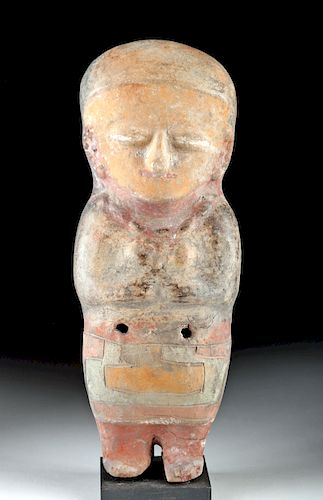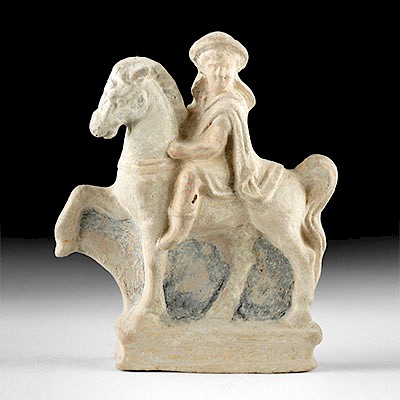Fine Bahia Polychrome Female Effigy Ocarina
Lot 127a
About Seller
Artemis Fine Arts
686 S Taylor Ave, Ste 106
Louisville, CO 80027
United States
Selling antiquities, ancient and ethnographic art online since 1993, Artemis Gallery specializes in Classical Antiquities (Egyptian, Greek, Roman, Near Eastern), Asian, Pre-Columbian, African / Tribal / Oceanographic art. Our extensive inventory includes pottery, stone, metal, wood, glass and textil...Read more
Estimate:
$600 - $900
Absentee vs Live bid
Two ways to bid:
- Leave a max absentee bid and the platform will bid on your behalf up to your maximum bid during the live auction.
- Bid live during the auction and your bids will be submitted real-time to the auctioneer.
Bid Increments
| Price | Bid Increment |
|---|---|
| $0 | $25 |
| $300 | $50 |
| $1,000 | $100 |
| $2,000 | $250 |
| $5,000 | $500 |
| $10,000 | $1,000 |
| $20,000 | $2,500 |
| $50,000 | $5,000 |
| $100,000 | $10,000 |
| $200,000 | $20,000 |
About Auction
By Artemis Fine Arts
May 9, 2019
Set Reminder
2019-05-09 10:00:00
2019-05-09 10:00:00
America/New_York
Bidsquare
Bidsquare : Ancient | Asian | Ethnographic
https://www.bidsquare.com/auctions/artemis-gallery/ancient-asian-ethnographic-4110
Featuring classical antiquities, ancient and ethnographic art from cultures encompassing the globe. All legally acquired, legal to sell. Satisfaction guaranteed. Convenient in-house shipping. Artemis Fine Arts info@artemisgallery.com
Featuring classical antiquities, ancient and ethnographic art from cultures encompassing the globe. All legally acquired, legal to sell. Satisfaction guaranteed. Convenient in-house shipping. Artemis Fine Arts info@artemisgallery.com
- Lot Description
Pre-Columbian, Ecuador, Manabi Province, Bahia culture, ca. 5th to 1st century BCE. A finely-molded pottery votive ocarina in the form of a standing woman holding her hands in front of her body. Her large, smooth head has a bulbous shape that reflects the tradition of skull-shaping within the culture and may indicate the social status of the individual after which this figure is modeled. The body is smooth and stylized, terminating in short, wide legs atop gently-tilted feet, and is accentuated with layers of yellow, red, and faded green pigment. The Bahia continued in the long Ecuadorian tradition of ceramic effigy making, and this one may have been used in rituals or as offerings. One archaeological site, on La Plata Island, has yielded thousands of broken effigy figures similar to this one. The instrument does not produce musical sounds when played. Size: 3.75" W x 10" H (9.5 cm x 25.4 cm); 10.4" H (26.4 cm) on included custom stand.
Provenance: private New York, New York, USA collection; ex-private lifetime collection of Dr. Saul Tuttman and Dr. Gregory Siskind, New York, New York, USA
All items legal to buy/sell under U.S. Statute covering cultural patrimony Code 2600, CHAPTER 14, and are guaranteed to be as described or your money back.
A Certificate of Authenticity will accompany all winning bids.
We ship worldwide and handle all shipping in-house for your convenience.
#145938Restoration to one foot and lower half of one tone hole on lower back. Minor abrasions and nicks to legs, body, and head, with fading to original pigmentation, and light encrustations. Nice earthen deposits and fabulous traces of original pigmentation throughout. Ocarina produces no musical notes when played.Condition
- Shipping Info
-
All shipping is handled in-house for your convenience. Your invoice from Artemis Gallery will include shipping calculation instructions. If in doubt, please inquire BEFORE bidding for estimated shipping costs for individual items.
-
- Buyer's Premium



 EUR
EUR CAD
CAD AUD
AUD GBP
GBP MXN
MXN HKD
HKD CNY
CNY MYR
MYR SEK
SEK SGD
SGD CHF
CHF THB
THB














